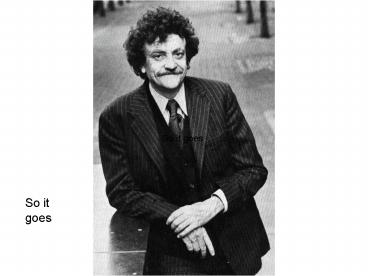Personal Learning - PowerPoint PPT Presentation
1 / 43
Title:
Personal Learning
Description:
http://www.cluetrain.com/ It looks like the internet... Like open source ... Like tagging and Digg and... It looks like Web 2.0. Stallman. Enter the Network ... – PowerPoint PPT presentation
Number of Views:90
Avg rating:3.0/5.0
Title: Personal Learning
1
So it goes
So it goes
So it goes
2
Personal Learning
- Stephen Downes
- April 12, 2007
3
Prologue
How do you teach if you no longer have power over
students?
We didn't start the fireIt was always burning,
since the world's been turning
Joel
http//home.uchicago.edu/yli5/Flash/Fire.html
4
Enter the Network
Everything is connected
to everything else
(Theory-laden data)
http//dsv.su.se/kjellman/e-subjectoriented.htm
Lakatos
5
Enter the Network
It is impossible to
predict anything (Chaos
theory, strange attractors)
Lorenz
http//www.imho.com/grae/chaos/chaos.html
6
Enter the Network
It is the breakdown of order
(Postmodernism, ethnocentricity)
(Cluetrain, We The Media)
http//www.cluetrain.com/
Derrida
7
Enter the Network
- It looks like the internet
- Like open source
- Like Social Networks
- Like blogs and blogging
- Like wikis and collaborative writing
- Like tagging and Digg and
- It looks like Web 2.0
Stallman
8
Enter the Network
- From the inside, you see the tubes
- Look for connections, interactions
- (or more concretely, XML and APIs)
It's not a truck. It's a series of tubes. And
if you don't understand those tubes can be filled
and if they are filled, when you put your message
in, it gets in line and its going to be delayed
by anyone that puts into that tube enormous
amounts of material, enormous amounts of
material.
9
Its Chaos!
- No principles or rules describing quality
- Individual preferences only
- No rubric or metric
- No peers or committee of experts
- Evaluations are not an aggregation no votes
Suroweicki
10
Kaboom!
11
The Idea of the PLE
http//www.cetis.ac.uk/members/ple/resources/edf.p
pt
12
Plex Personal Learning Environment Example
http//reload.ces.strath.ac.uk/plex/
13
Collecting and Filtering RSS
http//www.downes.ca/mygluframe.htm
14
RSS Writr
http//www.downes.ca/editor/writr.htm
15
Edu_RSS Viewer
http//www.downes.ca/cgi-bin/page.cgi?actionviewe
r
16
Edu_RSS 0.2
http//www.downes.ca/edurss02.htm
17
The Problem
How to find the right resource
- at the right time
- for the right person
18
The old way use descriptions
http//www.capuano.biz/Papers/ITS202000/ITS20200
0.htm
- Dublin Core
- Learning Object Metadata
19
Descriptions are (necessarily) incomplete
- many properties depend on context
- I know it when I see it
- these relations are dynamic and change
- from person to person
- from time to time
http//www-personal.umich.edu/kborders/photograph
y.htm
20
Recommender Systems
- The idea is that associations are mapped between
- User profile properties of given users
- Resource profile properties of the resource
- Previous evaluations of other resources
http//www.slideshare.net/Downes/projecting-qualit
y
http//www.slideshare.net/Downes/quality-standards
-its-all-about-teaching-and-learning/
21
Resource Profiles
http//www.downes.ca/files/resource_profiles.htm
22
knowledge has many authors, knowledge has many
facets, it looks different to each different
person, and it changes moment to moment
23
The key insight
Two very distinct problems are in fact instances
of the same problem. The problem of locating
the right resource on the internet is basically
the same problem as the problem of getting the
question right on the test.
24
Relations between Entities
25
Into this picture rides
Knowledge management?
the idea
Capture tacit knowledge
and then codify it
Hodgins
Learning Objects
26
You Cant Go Back Again
- personal knowledge
- tacit knowledge
Polanyi
Ineffable
Depends on Context
You cant generalize it
You cant put it into words
27
Knowledge is like recognition Learning is like
perception the acquisition of new
patterns of connectivity through
experience
Hume
28
Patterns in the Mesh
the knowledge is in the network
Old universals rules categories New
patterns patterns similarities
the knowledge is the network
Tenenbaum
http//www.bbsonline.org/Preprints/OldArchive/bbs.
tenenbaum.html
29
Pattern Recognition
Gibson
30
You already know this phenomenon, youve already
seen it
Emergent Learning
http//growchangelearn.blogspot.com/2007/02/emerge
nt-learning.html Tom Haskins
"Now I get it" A-ha! "Out of the blue" "My
mind leaped" "Did an about-face" "Shut up and
did it" Sudden breakthrough
http//www.downes.ca/files/osn.html
31
stands for?
Hopfield
Or is caused by?
Distributed Representation
a pattern of connectivity
32
(No Transcript)
33
Where is the PLE?
34
The way networks learn is the way people learn
35
This
Network Learning
- Hebbian associationism
- based on concurrency
- Back propagation
- based on desired outcome
- Boltzman
- based on settling, annealing
36
Leads to This
Personal Learning
To teach is to model and to demonstrate To learn
is to practice and reflect
37
What is the PLE?
38
We can get an idea of what the PLE looks like by
drilling down into the pieces
The question is how to transport and represent
models that are actually used?
- Model
- conceptual frameworks
- wiki (wiki API, RSS)
- concept maps (SVG, mapping format)
- gliffy (SVG?)
- reference frameworks
- Wikipedia
- video / 2L 3D representation embedded spaces
39
The question is, how can we connect the learner
with the community at work?
- Demonstrate
- reference examples
- code library
- image samples
- thought processes
- show experts at work (Chaos Manor)
- application
- case studies
- stories
40
The question is, how can we enable access to
multiple environments that support various
activities?
- Practice
- scaffolded practice
- game interfaces
- sandboxes
- job aids
- flash cards
- cheat sheets
- games and simulations
- mod kits
- mmorpgs
41
The question is, how can we assist people to see
themselves, their practice, in a mirror?
- Reflection
- guided reflection
- forms-based input
- presentations and seminars
- journaling
- blogs, wikis
- communities
- discussion, sharing
42
People talk about motivation but the real
issue here is ownership
- Choice Identity - Creativity
- simulated or actual environments that present
tasks or problems - OpenID, authentication, feature or profile
development - Portfolios creative libraries
43
http//www.downes.ca
Downes































